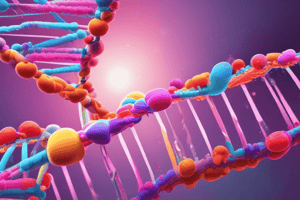Podcast
Questions and Answers
What role do proteins play in multicellular organisms?
What role do proteins play in multicellular organisms?
- They are the primary genetic material of cells.
- They solely provide energy for cellular processes.
- They act only as structural components.
- They dictate nearly every cell function. (correct)
What is the function of genes in the context of protein production?
What is the function of genes in the context of protein production?
- They determine the lifespan of proteins.
- They repair damaged proteins.
- They store energy for cellular functions.
- They code for the sequence of amino acids in proteins. (correct)
What process involves making a single-stranded mRNA copy of a gene?
What process involves making a single-stranded mRNA copy of a gene?
- Replication
- Translation
- Mutation
- Transcription (correct)
How many mRNA nucleotides correspond to one amino acid in a protein?
How many mRNA nucleotides correspond to one amino acid in a protein?
What does the order of amino acids in a protein determine?
What does the order of amino acids in a protein determine?
Which statement best describes the Central Dogma of molecular biology?
Which statement best describes the Central Dogma of molecular biology?
What is the first step in the process when a cell needs a particular protein?
What is the first step in the process when a cell needs a particular protein?
What is the role of the mRNA in protein synthesis?
What is the role of the mRNA in protein synthesis?
What are the three codons that do not code for an amino acid called?
What are the three codons that do not code for an amino acid called?
How are amino acids encoded in the genetic code?
How are amino acids encoded in the genetic code?
Which of the following amino acids is encoded by the codons UGU and UGC?
Which of the following amino acids is encoded by the codons UGU and UGC?
What is the role of the AUG codon in protein synthesis?
What is the role of the AUG codon in protein synthesis?
What does the redundancy in the genetic code allow for?
What does the redundancy in the genetic code allow for?
Why are there 64 possible codons in the genetic code?
Why are there 64 possible codons in the genetic code?
Which feature of the genetic code supports the idea of a common origin for life on Earth?
Which feature of the genetic code supports the idea of a common origin for life on Earth?
What is indicated by the fact that different codons can specify the same amino acid?
What is indicated by the fact that different codons can specify the same amino acid?
Which of the following describes a significant consequence of nucleotide redundancy in the genetic code?
Which of the following describes a significant consequence of nucleotide redundancy in the genetic code?
Flashcards are hidden until you start studying
Study Notes
Introduction to Proteins
- Proteins orchestrate nearly every cell function and influence traits of multicellular organisms.
- DNA serves as a blueprint for protein synthesis, with each chromosome comprising a single DNA molecule wrapped around proteins.
- Genes are segments of DNA that code for amino acid sequences in proteins, crucial for life.
The Genetic Code
- DNA holds genes that dictate the unique sequence of amino acids for each protein.
- The order of amino acids influences the protein's chemistry, folding, shape, and function.
- The genetic information flow follows the Central Dogma: DNA → mRNA → Protein.
Central Dogma of Molecular Biology
- When a cell requires a protein, the corresponding gene is activated to produce a single-stranded mRNA through transcription.
- During translation, the mRNA is read to determine the sequence of amino acids in the protein.
- Each nucleotide in DNA corresponds to one in mRNA, while three mRNA nucleotides (codon) correspond to one amino acid.
Universal and Redundant Genetic Code
- mRNA is read in three-nucleotide segments called codons, with 64 possible combinations from four nucleotides (A, C, U, G).
- 61 codons specify one of 20 common amino acids; the remaining three are stop codons that do not code for amino acids.
- The genetic code is largely universal across species, indicating a common origin of life; e.g., mRNA from horses can produce horse globin in tulips.
Redundancy in the Genetic Code
- The redundancy allows multiple codons to specify the same amino acid, reducing the impact of mutations.
- Codons with related amino acids often differ by only one nucleotide; for example, ACU and ACG both code for threonine.
- Cysteine and serine are encoded by similar codons, reflecting their chemically similar properties.
Stop Codons and Start Codon
- Out of 64 codons, three are stop codons that terminate protein synthesis, while the AUG codon serves dual purposes as a start codon for translation and codes for methionine.
- The reading frame for protein synthesis begins at the AUG codon located near the mRNA's 5' end.
Experimental Confirmation of Genetic Code
- The encoding of amino acids by nucleotide triplets was validated experimentally, establishing that two-nucleotide combinations (only 16 possible) are insufficient for all amino acids.
- The experimental design confirmed that nucleotide triplets are essential for specifying amino acids due to the 64 possible combinations available.
Studying That Suits You
Use AI to generate personalized quizzes and flashcards to suit your learning preferences.




